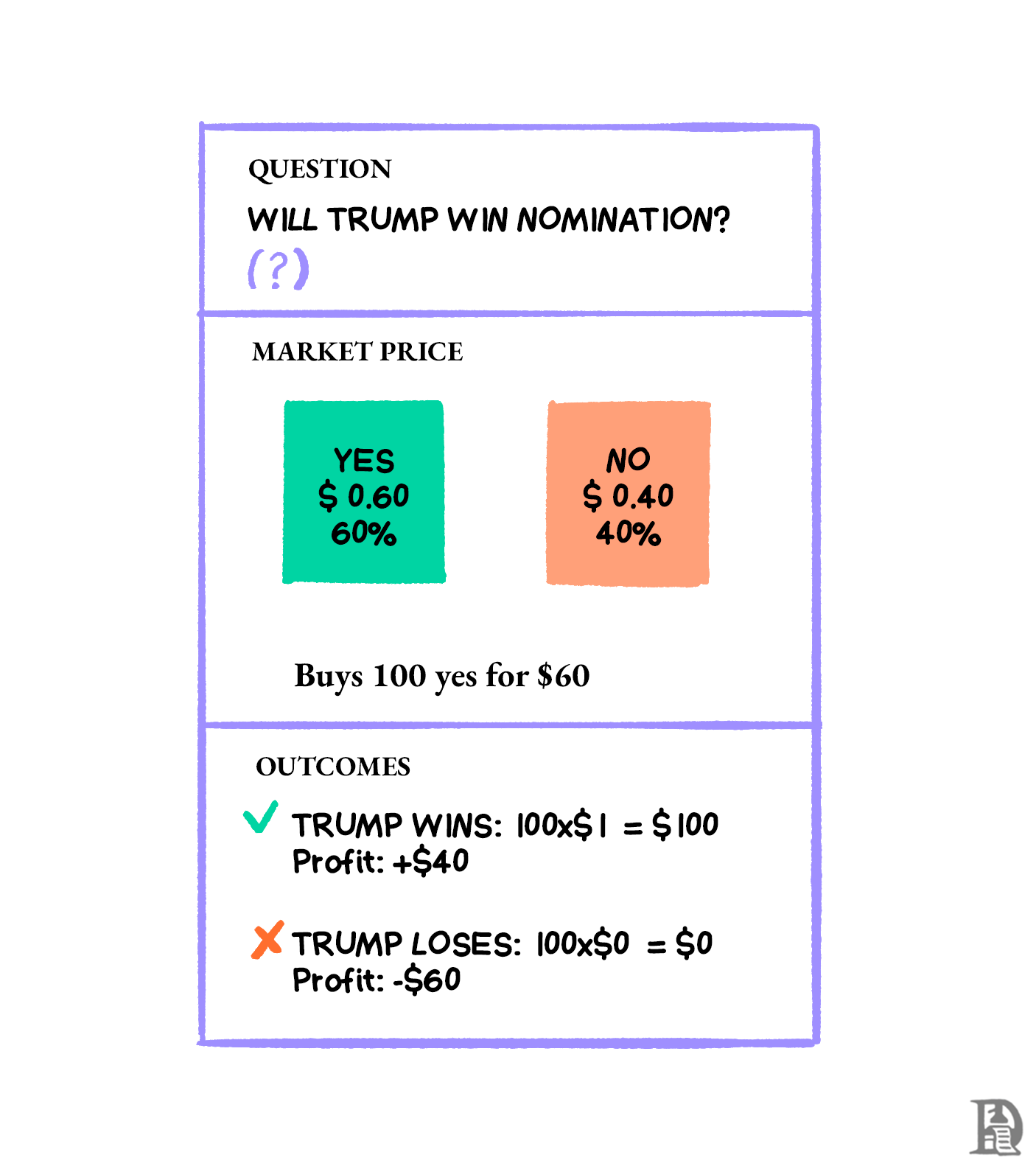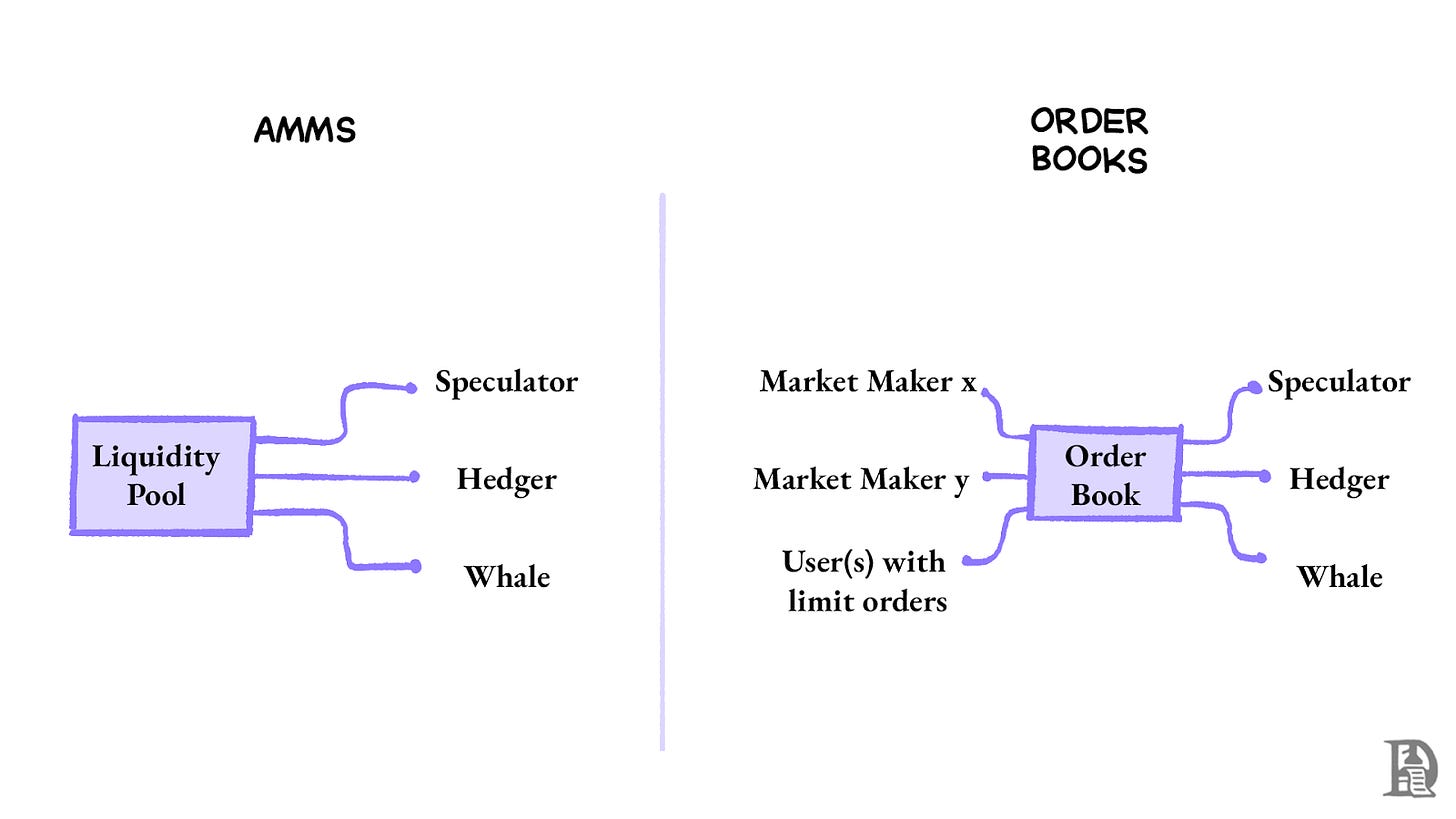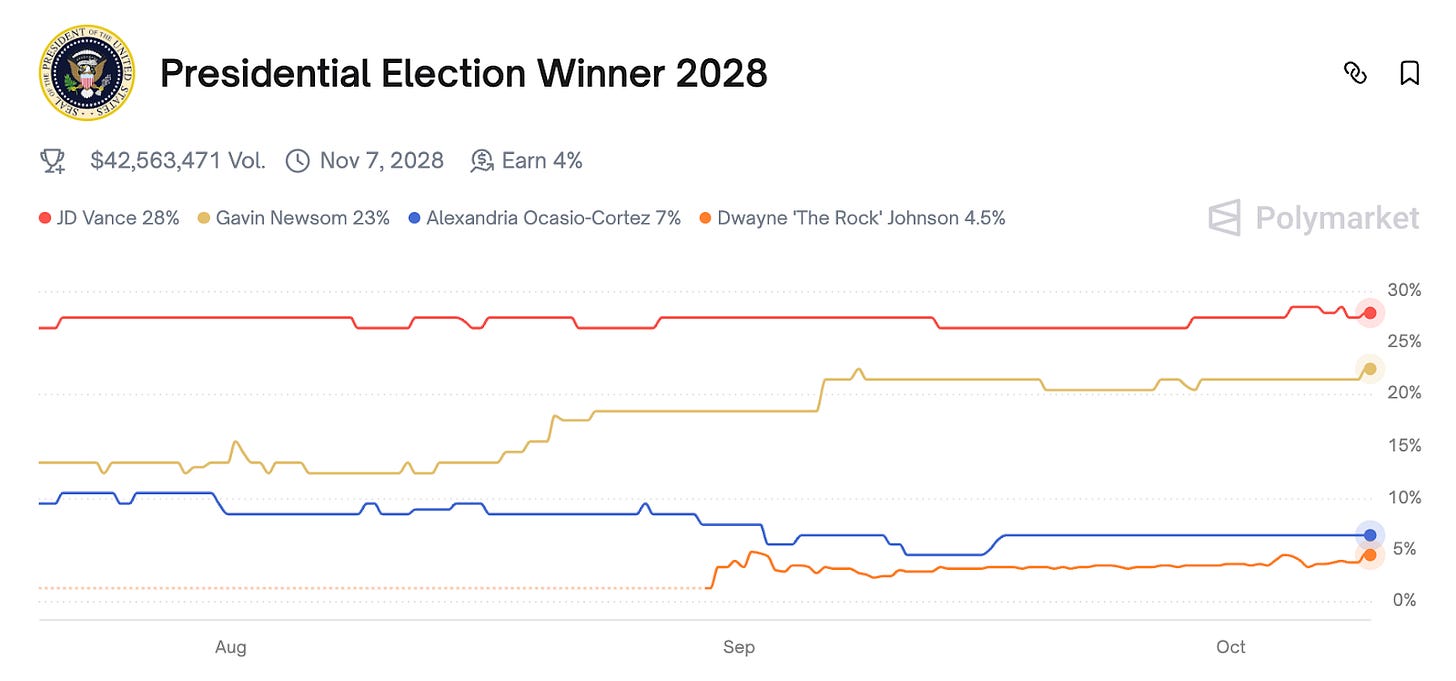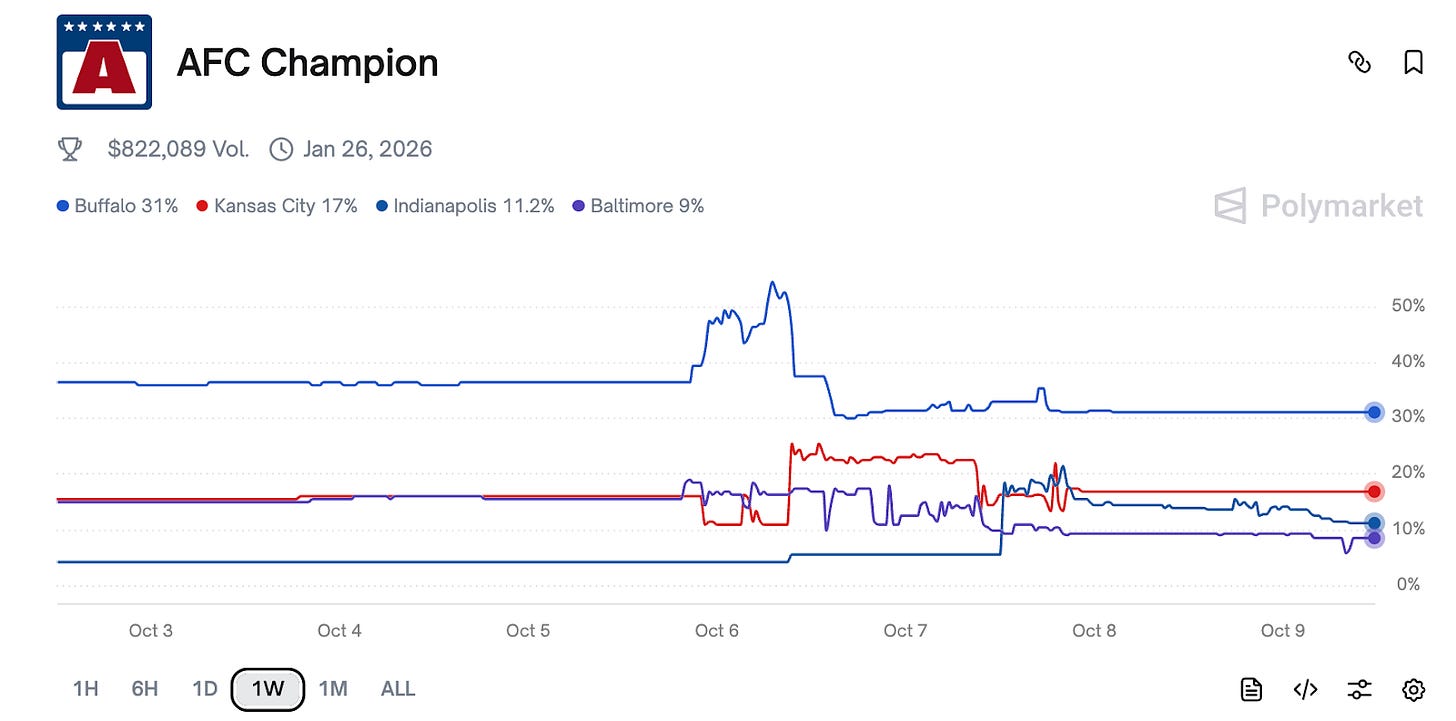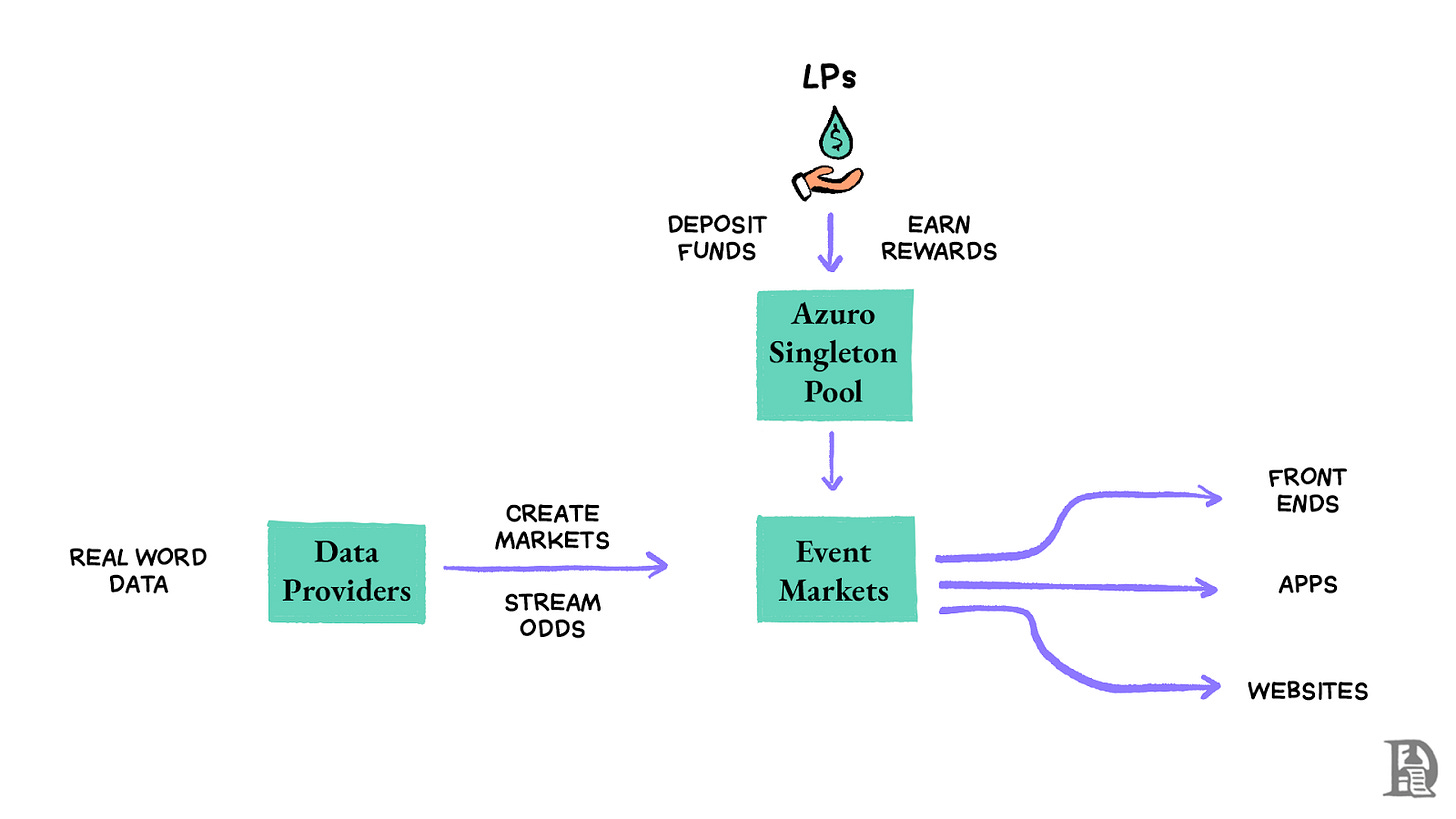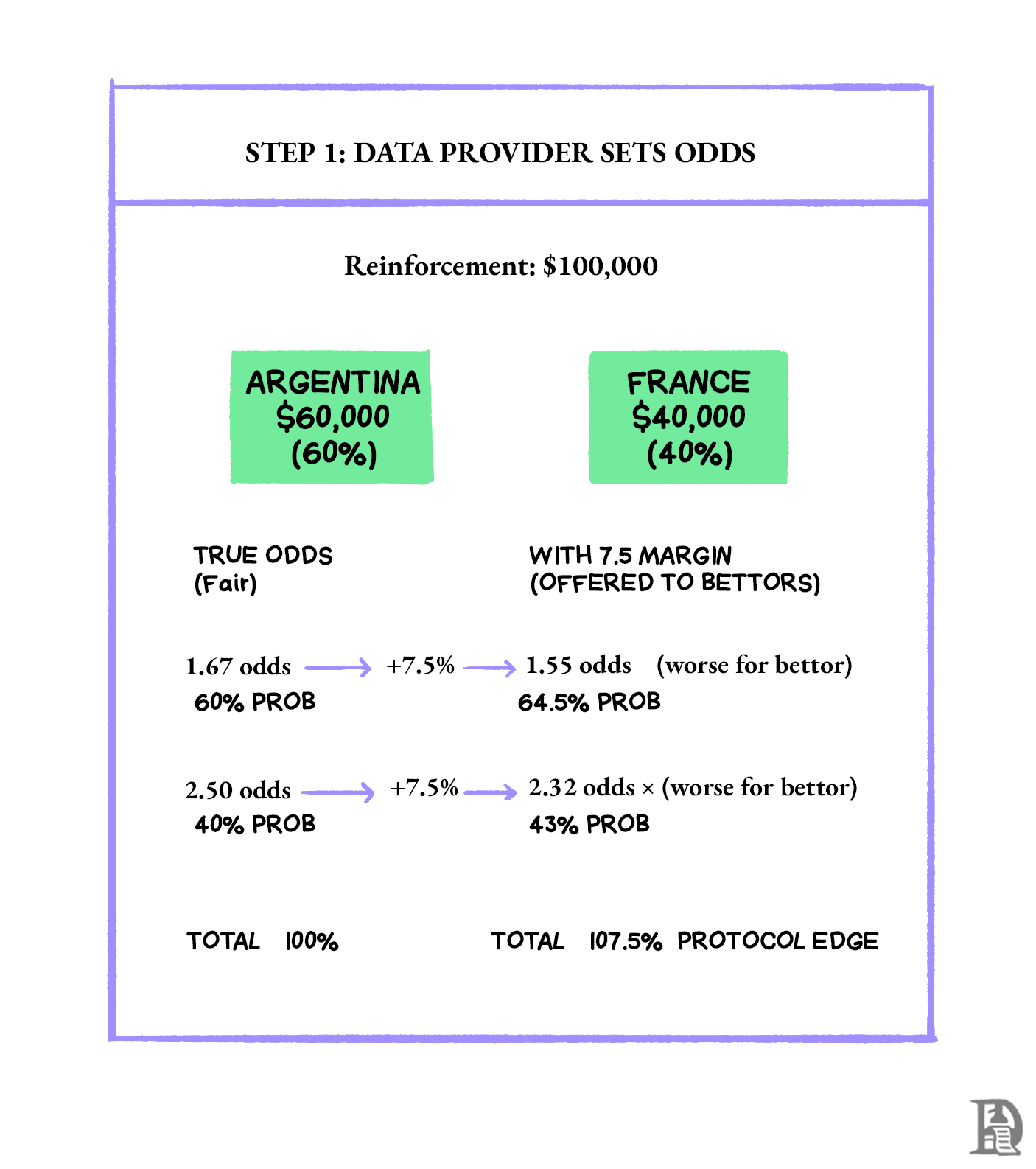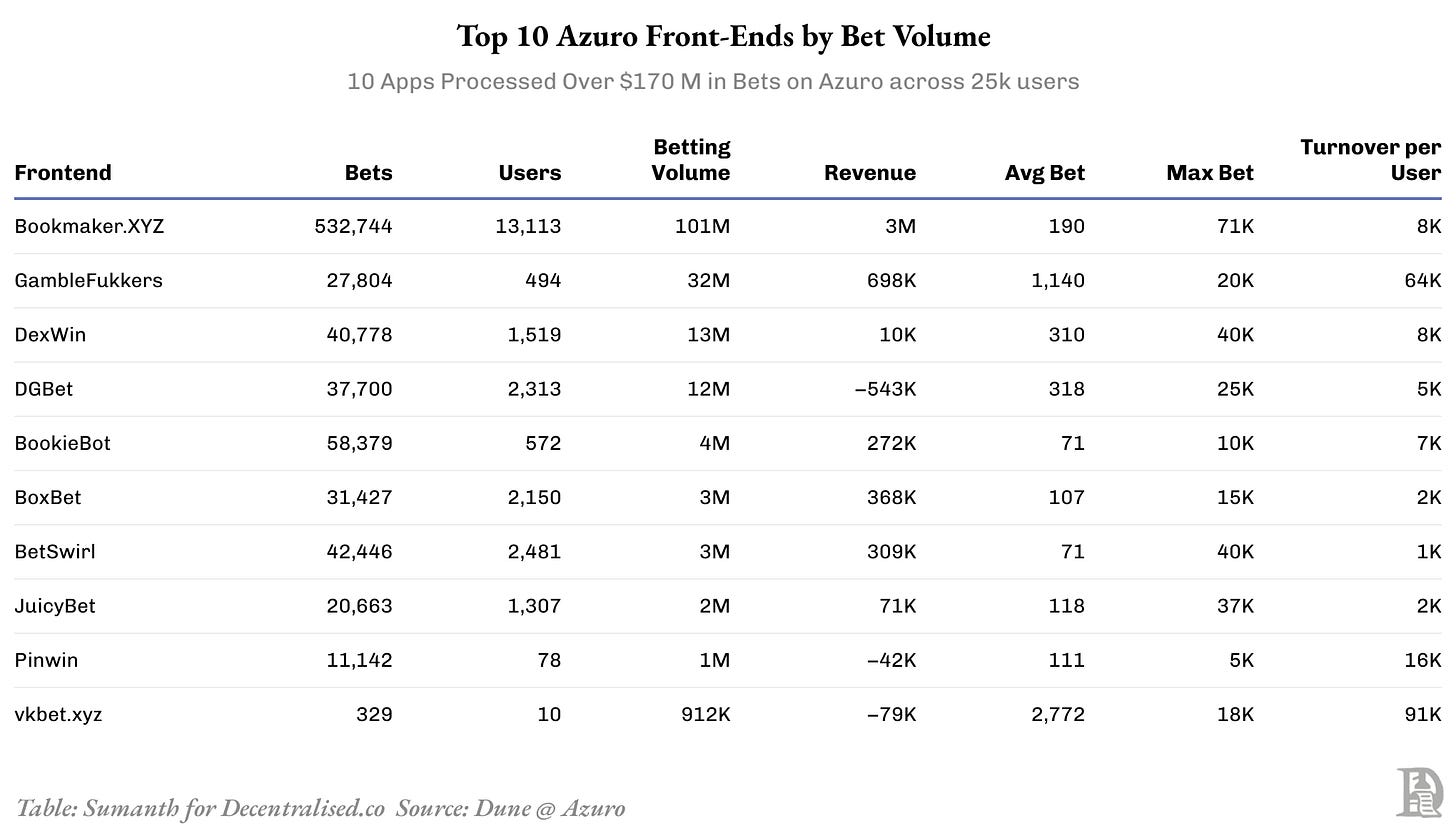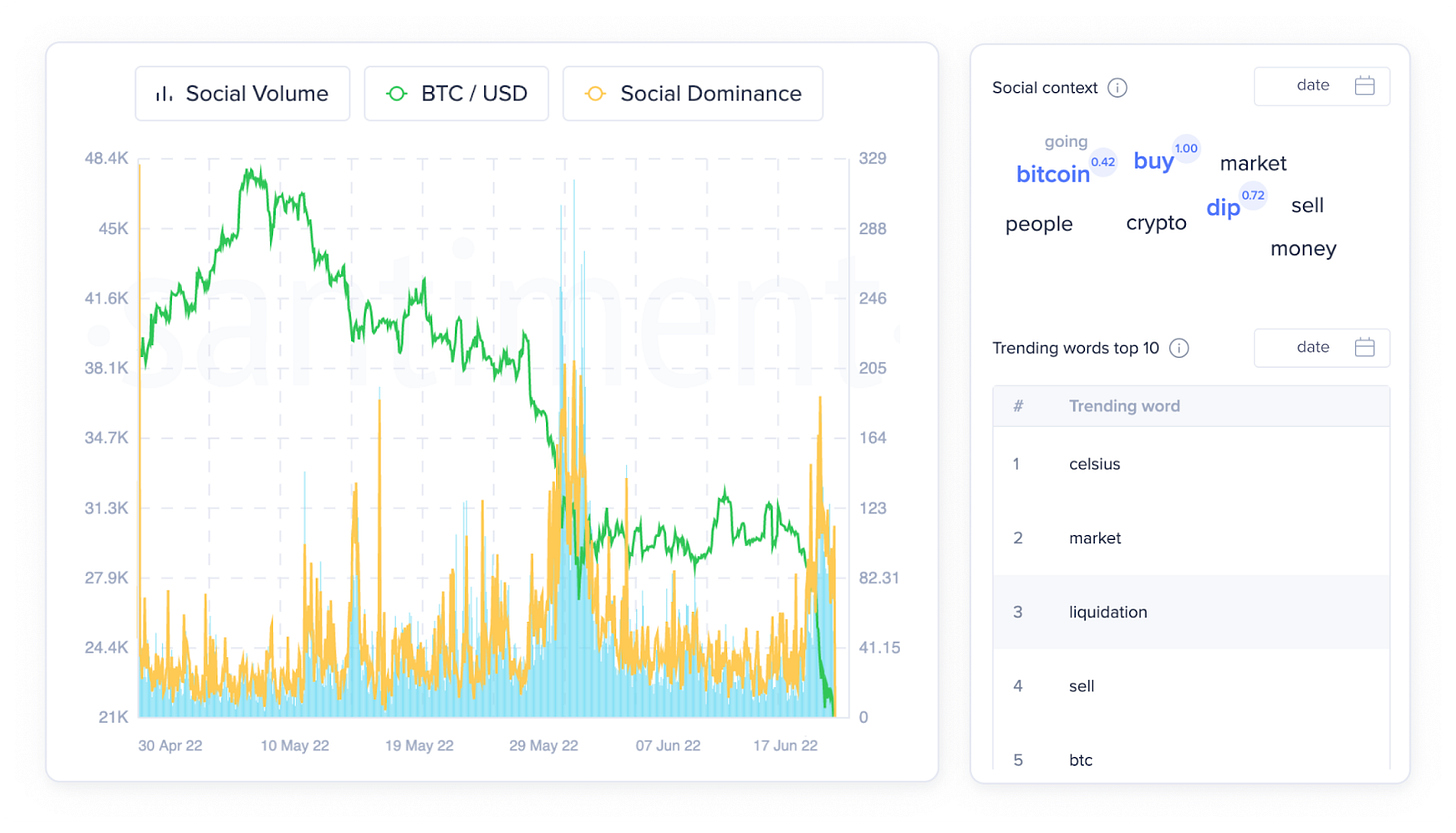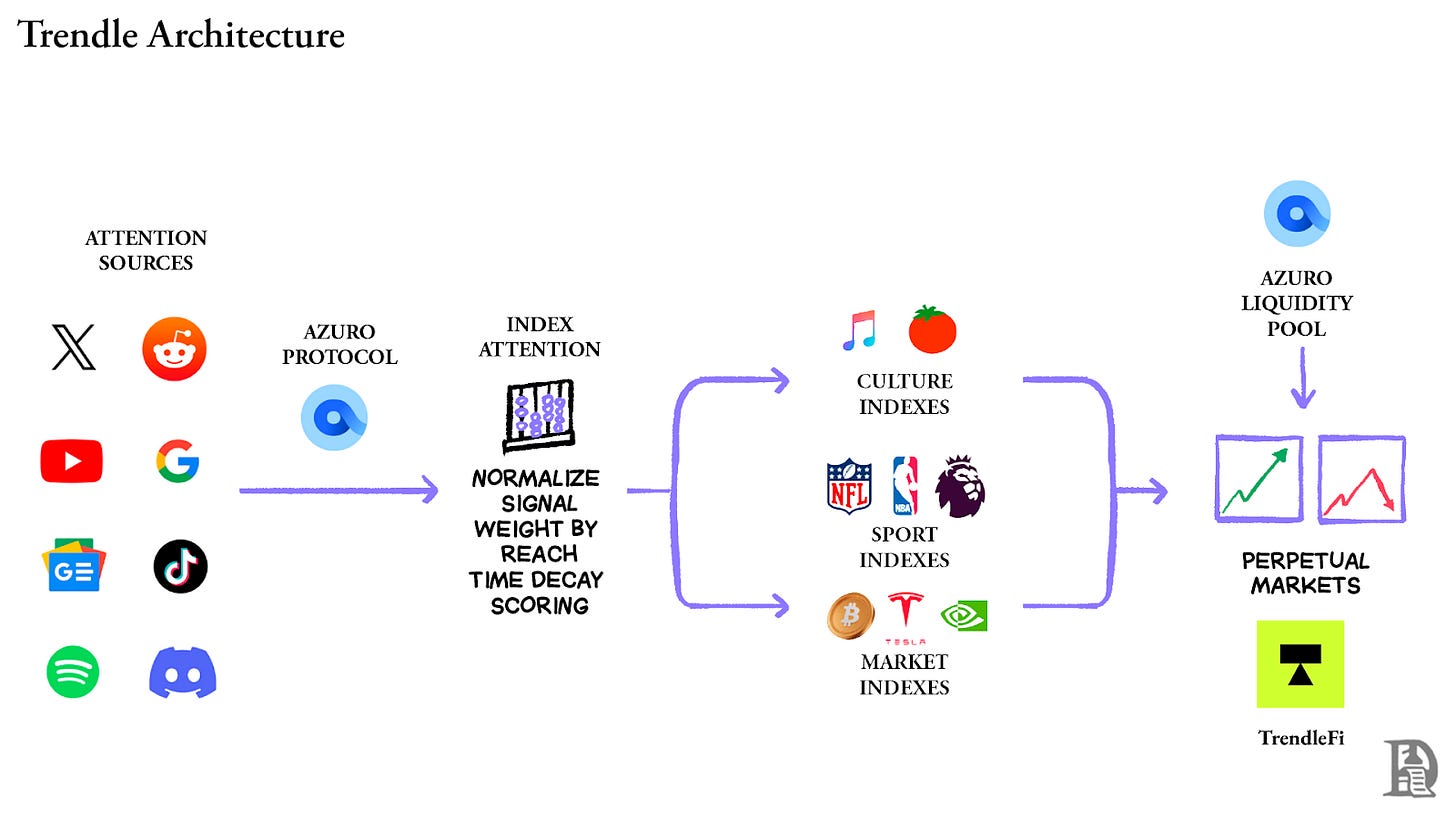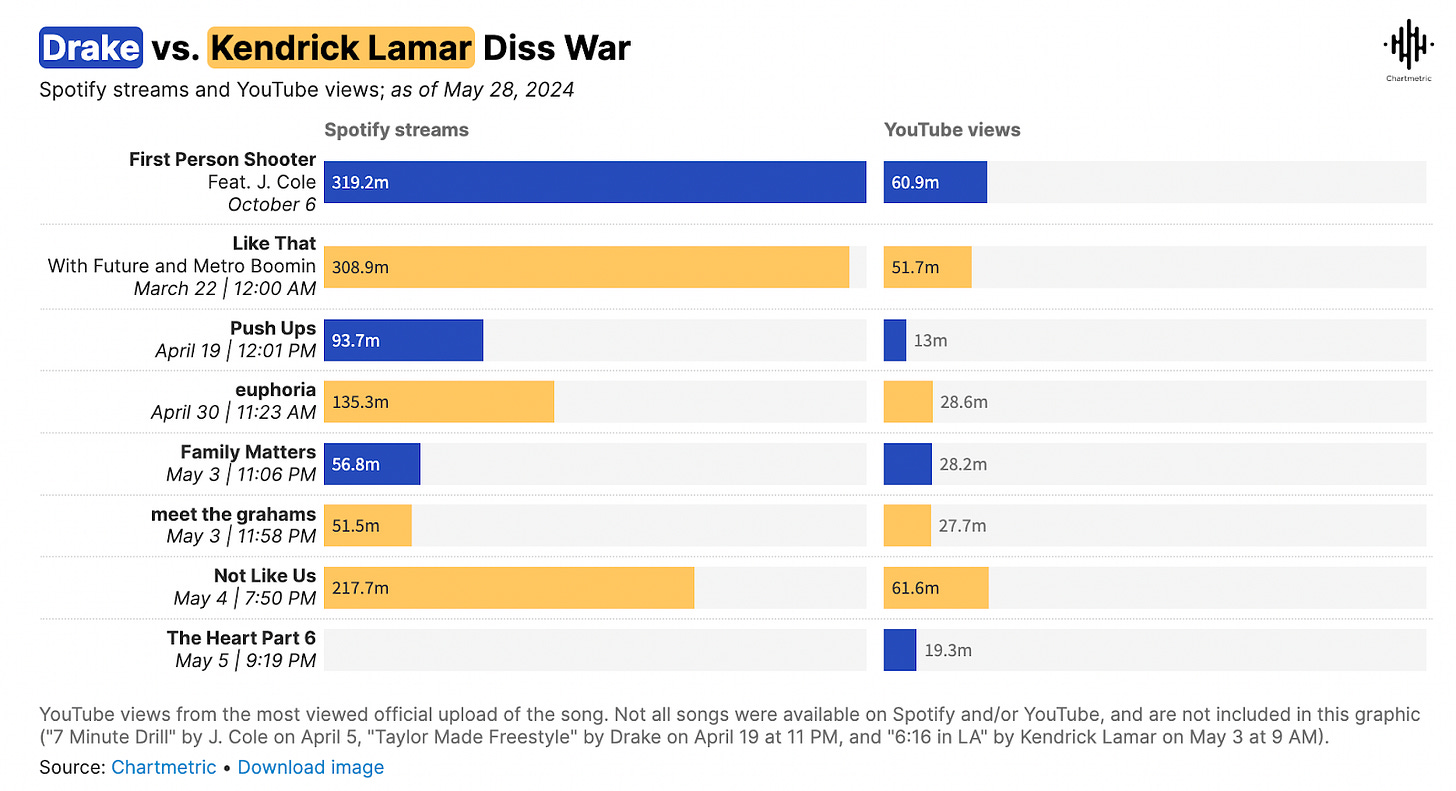Trending Liquidity
Money pipelines for attention
Hello!
Prediction markets made crypto relatable. All of a sudden, people could bet on athletes, celebrities, and politicians. Crypto pay rails now power an economy for attention and value globally, but many of these markets are isolated and spread too thin. How do you bring liquidity to scale? Many of the experiments that helped DeFi scale, such as aggregation or liquidity provisioning in AMMs, are now being applied to prediction markets.
Today’s piece, written in collaboration with Azuro and Trendle, is a breakdown of how liquidity flows across markets through their protocol in prediction markets. Last week, I wrote about how curated social feeds on Web3 social graphs could be a necessary primitive to replace surveillance economies. The week before, I broke down how embedded markets will change the unit economics of attention.
Azuro and its flagship product, Trendle, look like what would happen when these themes merge. Sumanth breaks down how the product came to be, why it matters, where it fits, and how it compares to traditional equity in today’s piece. It is a brilliant breakdown of what prediction markets would need to scale a hundred times from here.
If you are building plumbing for these new markets or conceptualizing them, we’d love to speak to you. Venture@decentralised.co is the best place to reach out. We are steadily building up a portfolio of companies around the theme.
Joel
On election night 2024, Polymarket showed clear conviction while television pundits had it wrong. The prediction market had Donald Trump at 58% to win hours before major networks called the race. By the time the results were official, Polymarket had processed $3.2 billion in trading volume, proving what many had long suspected: that markets aggregate information more effectively than experts.
This wasn’t Polymarket’s first validation, but its most visible. Throughout 2024, the platform had become the default source for real-time probability on everything from Fed rate decisions to Supreme Court rulings. Political analysts cited its odds in op-eds. Traders used it to hedge positions. Casual observers checked it like weather forecasts. After years of regulatory limbo and false starts, prediction markets had finally arrived.
Within months, the legal fog that shadowed prediction markets began to clear. A DC Circuit ruling allowed Kalshi to list congressional control contracts under the CFTC’s supervision.
For years, prediction markets faced a patchwork of restrictions - banned in most U.S. states, tolerated in others, operating offshore to serve American users while technically violating terms. The ruling paved the way for a clear regulatory path for event markets.
CFTC-supervised exchanges can now list event contracts nationwide, superseding state-by-state regulations for sports betting. Polymarket acquired a CFTC-licensed venue in early 2025, securing its route back into U.S. markets after operating offshore.
Now the money and the licenses are catching up. Intercontinental Exchange (ICE), the owner of the NYSE, is investing $2 billion in Polymarket, valuing it near $10 billion post-money and positioning ICE to distribute event-driven data to Wall Street clients. Kalshi has also raised $300 million at a $5 billion valuation from investors like Andreessen Horowitz (a16z), Sequoia Capital, and Paradigm. It signals that “odds as a data feed” is moving from crypto novelty to institutional plumbing.
The scale of what’s being built extends far beyond politics. Global sports betting is a $140 billion annual market. Add financial event contracts - Fed decisions, GDP prints, corporate earnings, and you’re past $200 billion. Layer in cultural prediction markets for entertainment, social trends, and product launches, and the addressable market approaches half a trillion dollars. Anything with an uncertain outcome that people care about can become a tradable market.
As prediction markets gain legitimacy, they risk becoming what they were meant to disrupt. Polymarket is permissionless in theory but centralised in practice. The company controls the order book, determines which markets are listed, and can freeze accounts or block regions at its discretion. It’s crypto-enabled, allowing users to deposit assets and participate, but the markets are not on-chain. Kalshi is a centralised Prediction Market that’s currently building out its crypto team to accelerate moving on-chain.
This is where infrastructure protocols that bring liquidity on-chain matter. Azuro’s protocol combines traditional odds-making with AMMs and settles everything on-chain. Rather than controlling the experience, Azuro enables it, providing a single concentrated liquidity pool that any front-end can tap, connecting professional data providers to create markets, and allowing permissionless access for builders. This architecture addresses several longstanding issues in prediction markets, including high fees, geographic restrictions, and opaque odds-making processes.
In today’s sponsored collaboration, we examine how Azuro’s approach—featuring a single concentrated liquidity pool, professional data providers, and permissionless front-ends — creates a more efficient and accessible betting market. We’ll explore the core mechanics, analyse the growing ecosystem, and assess whether Azuro can fulfil its ambitious vision of creating a new market for attention.
How Prediction Markets Work
Prediction markets are coordination engines. Their power lies in how they match people with different convictions. Someone who follows polling data closely believes Trump’s odds are undervalued at 60% and will buy until the price reflects their view; someone who thinks the market is too optimistic will sell.
The ones who get it right win it all. It is a zero-sum game. But how do you ensure there’s always someone on the other side of the trade? There are two architectures with different tradeoffs - Order books and AMMs.
Order books are the oldest and most familiar. They work like exchanges: users post bids and asks, such as “I’ll buy Yes at $0.58” or “I’ll sell Yes at $0.62”. Trades execute when they meet. Prices emerge organically from the tension between buyers and sellers. When there’s enough liquidity, spreads tighten to less than 1 cent. That’s how political markets look during election weeks with deep books and tight spreads. Market makers also step in to supply liquidity and earn a commission for facilitating trades. It’s the same machinery that keeps Hyperliquid operating on tight spreads.
The problem is liquidity fragmentation. Each market needs its own set of active buyers and sellers, maintaining two-way pricing. A market on “Fed Decision on October?” might have 5000 active traders providing liquidity with $70M in open interest. However, a market on “Richest person on December 30” might have only 20 traders with $2 million in open interest. Thin markets have wide spreads, making them effectively untradeable. Market makers also step away when markets are shaky, as we saw in the recent $19B wipeout.
Automated Market Maker (AMM) models solve this through pooled liquidity. Instead of peer-to-peer trading, users trade against a pool of liquidity governed by a mathematical curve. The more Yes tokens you buy, the more expensive they get. The best-known version is the Constant Product Market Maker (CPMM), used by Uniswap, which ensures liquidity is always available.
AMMs are elastic and open, capable of spawning new markets instantly without waiting for counterparties to establish them. But that flexibility costs precision. To achieve the same depth as an order book, an AMM needs far more locked capital. The result is slippage; a $10,000 trade can move a market from 60¢ to 65¢ as it consumes liquidity along the curve. Order books could execute the same size at 61¢.
The Sports Betting Problem
The limits of current prediction markets show up clearly when you zoom in on sports. Elections or policy events evolve slowly, and probabilities shift as new information becomes available. Sports are chaotic, compressed into minutes. A goal, a red card, or a split-second VAR reversal can swing the odds by 50%. The infrastructure that works for macro-scale prediction breaks under that tempo.
During the 2022 World Cup final, France’s win probability jumped from 5% to 60% in under two minutes after Mbappé’s second goal. Any market maker maintaining an order book would face catastrophic losses as their stale orders get instantly sniped.
Traditional sports bookmakers employ sophisticated trading desks precisely to handle such rapid swings, adjusting odds in microseconds to protect their positions. You can’t expect retail users to monitor every match, ready to cancel and repost orders within seconds of a goal being scored. After a few experiences getting sniped, rational liquidity providers stop posting orders on sports markets.
The scale problem compounds it. A typical Polymarket election might host thirty or forty active contracts at once. A single sportsbook covers thousands of events. Every match, goal, corner, and card is priced in real time. Each of those markets needs active liquidity to stay tradable. The math doesn’t work. Fragmented liquidity makes it impossible to run deep, responsive odds without massive capital overhead.
Despite these problems, Prediction Markets are focusing on the $140 billion sports betting industry because of the advantages they bring. Traditional sportsbooks are black boxes. They maintain 5-8% margins on typical bets, refuse payouts at their discretion, freeze accounts without explanation, and arbitrarily ban winning players. Users have no recourse beyond contacting customer service or hiring lawyers.
But in their current form, prediction markets cannot scale to fill that gap. Kalshi and Polymarket today handle around $1 billion a month. Global sportsbooks handle more than $20 billion in the same time. All of Polymarket’s election-year frenzy equals a single busy weekend for DraftKings, Bet365, and FanDuel combined.
In their current form, Prediction markets are dependent on liquidity providers to step in. Estimates suggest that liquidity disparities have led to price discrepancies of around 15% during peak trading hours, eating into user gains. Better liquidity management solutions are needed to improve the user experience of on-chain prediction markets.
Enter Azuro.
Azuro
On a chilly morning in Yerevan, Armenia, in 2012, Paruyr Shahbazyan launched a modest website using a $50 template. His mission was ambitious yet straightforward - to bring transparency to the murky world of sports betting. Having spent years as a professional bettor himself, he had an intimate understanding of the industry’s problems: bookmakers refusing payouts, mysterious account freezes, and odds that seemed to shift unfairly against winning players.
Through his platform Bookmaker Ratings, he helped recover over $12 million for wronged bettors, building deep trust within the community. But as cryptocurrency payments began flowing into betting sites and blockchain technology matured, Shahbazyan saw an opportunity to solve these problems at their root. With Azuro, he set out to create an on-chain betting protocol that would make intermediaries obsolete.
Azuro’s core idea is to rebuild the sportsbook’s machinery as public infrastructure. Instead of every market maintaining its own liquidity pool, Azuro runs a single shared pool. One reservoir of capital that dynamically allocates funds across thousands of outcomes. The protocol acts as a financial grid: when liquidity demand spikes around the World Cup, the same capital that was idling in eSports or regional matches can instantly flow there. When Europe sleeps, that liquidity rebalances to American games.
Azuro’s ecosystem comprises three primary interconnected actors:
Data Providers sit at the heart of the system, playing a role similar to traditional odds providers, such as Sportradar. They create betting markets, stream live odds, and resolve outcomes.
Front-end Applications (or simply Apps) are the consumer-facing layer that punters actually interact with. Rather than building its own betting interface, Azuro enables anyone to create applications that leverage its liquidity and markets.
Liquidity Providers are the financial engine. By depositing capital into Azuro’s single pool, they gain exposure to every betting market on the platform. Think of them as the house - but rather than running complex trading operations, they provide capital and earn returns.
When a Data Provider creates a new market, they specify something called the “Reinforcement” amount. This reinforcement represents the maximum potential loss the pool could face from this specific market. However, and this is crucial, the pool doesn’t actually lock up this full amount. Instead, it uses a system of Virtual Funds to track real-time liquidity needs.
The Data Provider distributes this reinforcement across two possible outcomes based on their analysis:
Argentina Win: $60,000 → 1.67 odds (60% probability)
France Win: $40,000 → 2.50 odds (40% probability)
The protocol doesn’t actually offer these “true” odds to punters. Instead, it adds a 7.5% margin by increasing each probability by 7.5%, resulting in slightly reduced odds:
Argentina Win: 1.55 (instead of 1.67)
France Win: 2.32 (instead of 2.50)
This margin is how Azuro ensures long-term profitability—similar to how traditional bookmakers add their vig. The difference lies in transparency. This margin is fixed and publicly visible, unlike the opaque and variable margins often buried in traditional betting odds.
As pre-match betting heats up, the bets start flowing. Saurabh, confident in Messi’s destiny, places a $2,000 bet on Argentina at odds of 1.55. Joel, backing the defending champions, puts down $1,500 on France at 2.32.
The virtual fund for a market is calculated as the reinforcement minus the sum of all bets minus the maximum potential payout. In other words, it tracks the maximum liability of the protocol in the worst-case scenario. For our example, after our duo makes their bets, the Virtual Fund changes to:
Initial reinforcement: $100,000
Sum of placed bets: $3,500 ($2,000 + $1,500)
Maximum potential payout: $3,100 (if Argentina wins)
Profit for Pool with Slippage at 7.5%: $200 from Joel + $200 from Saurabh
Virtual Fund = $100,000 - $3,500 - $3,100 = $93,400
When Messi scores in the 23rd minute, the data Provider temporarily pauses the markets while updating the odds. These new odds trigger an automatic recalculation of the Virtual Funds. If they remain positive, betting continues. If any Virtual Fund approaches zero, that particular outcome stops accepting bets until either existing positions are settled or more liquidity becomes available.
If any disputes arise over resolutions, AzuroDAO acts as the final arbiter through on-chain voting, with voting power corresponding to the staked AZUR tokens and the duration of staking.
This “pool” architecture is paired with the Liquidity Tree, a mechanism that tracks every active bet and redistributes virtual funds to maintain solvency across all outcomes. Liquidity providers are exposed to the aggregate flow of the entire protocol. It’s like being the house in every sportsbook simultaneously, but with algorithmic risk management and transparent accounting.
This architecture proves particularly powerful for what the industry calls “long-tail events”—matches or tournaments that attract fewer bets. Traditional bookmakers often avoid these markets entirely because maintaining separate liquidity pools isn’t economically viable. However, Azuro’s singleton pool can support a Division 2 football match in Bulgaria with the same infrastructure that backs World Cup finals. The protocol allocates smaller reinforcement amounts to these markets while maintaining the same efficient capital utilisation across the entire system.
Banking on the House
For as long as organised betting has existed, being “the house” has been an enviable position. William Hill began as a single bookmaker in 1934 and has since grown into a multi-billion-pound operation. Bet365 started from a portable building in Stoke-on-Trent and is now worth over £7 billion. In betting, the house rarely loses.
Azuro democratises this position through its liquidity provision mechanism. Rather than William Hill’s family or Bet365’s Coates clan controlling all the upside, anyone can become a partial owner of the house by depositing capital into the protocol’s singleton pool.
The mechanics are straightforward: deposit assets into the pool and start earning a share of betting activity across every market the protocol supports. Think of it like buying shares in a global sportsbook, but with near-instant liquidity and without the corporate overhead. In our World Cup Final example, when the protocol generated $400 in profit from Saurabh and Joel’s bets, LPs collectively earned $80—their 20% share of the revenue. Scale this across thousands of daily bets, and those small percentages compound into historical returns averaging 15-20% APY.
The accounting system operates similarly to other DeFi vault models, such as Hyperliquid’s LP vault or GMX’s GLP pool. Your deposit gives you a proportional claim on the pool’s net asset value. As bets settle, profits and losses flow through in real-time, adjusting everyone’s position simultaneously.

This isn’t entirely risk-free money. When liquidity providers (LPs) first deposit funds, they are subject to a mandatory 7-day lock period. This prevents sophisticated traders from gaming the system by quickly entering and exiting positions around major sporting events. During this initial week, and sometimes extending into the first month, positions typically show negative returns.
This is by design; the protocol’s accounting system requires time to attribute profits and losses across the LP base accurately.
The protection mechanisms are equally sophisticated. Remember how Data Providers can pause markets during sudden events, like when Mbappé scored those two quick goals? This also protects LP capital from extreme swings. The protocol even implements automatic “stop-loss” thresholds that pause markets if potential losses approach dangerous levels.
The Nature of Choice
Azuro has processed $361 million in betting volume across 44 front-end applications. Activity grew steadily to over 23 million monthly transactions at its peak. The protocol has attracted over 34,000 unique users who’ve shown meaningful engagement, placing an average bet volume of $5,000.
Single bets make up the bulk of activity with $170 million in volume, while combo bets have attracted nearly 250,000 wagers worth $13 million. Azuro’s growth has been particularly notable in regions where traditional betting faces significant challenges. The protocol has seen substantial adoption in Latin America and Turkey, regions with passionate sports cultures but complex relationships with betting.
Take Turkey, where sports betting is technically legal but heavily restricted to a state-owned monopoly. Combine this with strict capital controls and a volatile currency, and you have millions of sports fans effectively locked out of global betting markets. Meanwhile, across Latin America, a patchwork of regulations and limited access to international payment systems creates similar barriers.
Azuro taking care of all the backend work creates powerful incentives. Consider a Vietnamese developer who identifies an opportunity to cater to local football fans struggling with English-language betting sites. They can build a culturally tailored interface with local language support, regional payment methods, and Vietnam-specific marketplaces. Another team might focus on creating the smoothest mobile experience for African users, while a third could integrate betting widgets directly into football statistics websites. The protocol’s liquidity pool instantly plugs into any event.
For users in these regions, decentralised betting solves multiple problems at once. They can access global betting markets without worrying about currency restrictions or complex KYC requirements. More importantly, they can be confident that successful bets will actually be paid out, which is a serious concern when using other alternatives.
From Sports to Attention
Prediction markets are splintering into every niche, like sports, politics, culture, and finance. But the thing they all circle around has never been directly tradable: attention. The internet figured out how to price clicks decades ago. It never figured out how to price the scarce focus that decides what trends, who sells out a drop, or which idea crosses the chasm.
With roughly five billion people on social platforms, feeds work like a 24/7 global exchange for human attention. Brands and creators already pay for it through ads, sponsorships, and collabs. Meta’s ad business generated $160 billion, which is approximately 98% of its total revenue. That’s roughly more than twice what global newspapers bring in.
The tools we have now measure attention, but don’t let you trade it. Google Trends shows which topics are spiking in search interest. “Ozempic” searches increased 300% in 2023, while “Strava” searches declined 40%. But you can’t bet on that shift six months before Novo Nordisk’s stock reflects it.
Social media analytics platforms, such as Brandwatch and Sprinklr, track brand mentions and “share of voice” across various platforms, providing Fortune 500 companies with data on how they are dominating the conversation compared to their competitors. News organisations use tools like CrowdTangle to spot which stories are going viral in real-time. Nielsen’s Social Content Ratings measure what Americans are watching on TV.
Brands currently make decisions using these descriptive tools. They check Google Trends to see if a topic is hot. They use platforms like HypeAuditor or Social Blade to catalogue top creators by follower count and engagement rates. They look at metrics - followers, likes, comments, shares, and partner with whoever has the highest numbers. A brand launching an energy drink might want to partner with fitness influencers. The ROI for these deals is calculated by the number of followers and the average engagement rate per follower.
This system is backwards. It measures what already happened (followers accumulated over years, past engagement) and assumes it predicts what will happen (future campaign performance). But attention doesn’t work like that.
A creator with 5 million followers might be experiencing declining relevance, while a creator with 500K might be on a rocket trajectory. Follower count is a lagging indicator. Attention momentum is what matters.
Santiment does a version of this for crypto. The platform tracks social volume, sentiment scores, and development activity across crypto assets, pulling data from thousands of Telegram channels, Reddit threads, Twitter accounts, and GitHub repos. Traders use it to spot narrative shifts before they hit price. When “Bitcoin ETF” social mentions surged in December, users saw the narrative building weeks before the actual approval.
Kaito made it much easier to track mindshare among hot narratives and identify which creators are driving market movements. You can see “Stablecoins” heating up, while the “AI agents” trend is slowing down. However, this is constrained to crypto. You can’t use it to compare whether “Barbie” is getting more buzz than “Oppenheimer,” or whether people care more about the new iPhone than whatever OpenAI’s new video model is.
The natural evolution is trading narrative momentum across verticals, treating it like a sector index instead of picking individual stocks. Take an example, if you believe AI is going to eat up search, you can long “AI search engines”. You’re betting on the conversation shift, not trying to pick whether Perplexity’s Comet or ChatGPT wins.
What’s missing is a clean, tradeable index, something you can go long when a narrative is building or short when it’s turning stale, without spinning up a token or running a media buy.
That’s where Trendle enters the frame. It sits on Azuro’s rails, using the same liquidity logic that made sports betting scalable, but applies it to the internet’s most universal commodity: mindshare.
Trendle: Trading the conversation
If prediction markets price answers to questions, attention contracts price the conversation itself. You pick a topic the world is buzzing about, bet ‘Up’ if you think attention rises or ‘Down’ if you feel it fades, and if conviction is high, use Boost for up to 5× leverage.
Under the hood, the architecture is more precise than “just counting mentions.” Azuro’s protocol aggregates signals from multiple platforms, including Twitter, Reddit, and YouTube. Data for every topic is continuously pulled from each of these platforms, and each raw signal is adjusted to a common baseline because these platforms differ in scale.
What this means is that Reddit’s thousands of daily posts versus YouTube’s billions of views are normalised, and the system sums activity into a single value, aligning every platform’s data onto the same time grid.
These engagement signals are transformed through a time-decay function, so more recent activity carries extra weight. The result is a composite attention index that reflects momentum, not raw volume. The last step is to measure the delta change in the index over a seven-day memory. This allows Trendle to capture spikes (such as a viral tweet) and persistence (when a narrative sustains itself over days).
With these indexes, it’s not about perfect counts but signal momentum: did the attention index go up or down over the defined period? It’s a bet on momentum, not on absolute volume.
The system is also designed to resist gaming: it cross-checks activity across platforms, flags anomalies in engagement ratios, and limits the weight any single entity or channel can contribute. In the future, Trendle can add more data sources, such as Discord, Spotify, and Google searches, to increase coverage.
Prediction markets often have hard deadlines; trends do not. Topics can explode and crash in hours. Instead of fixing a precise outcome, Trendle uses directional resolution: the question is not “what’s the exact score?” but “did attention rise or fall over the window?
Sports betting taught Azuro how to handle fragmented, spiky markets. Attention behaves the same way. It fragments into thousands of micro-topics that emerge in different time zones and fade just as quickly. Most of these markets are too thin for order books. Spinning up a new pool for each market is just capital that sits there.
This is where perps fit better. Instead of liquidity flowing across different markets, the Azuro team built a product called Trendle that backs perpetual markets across these cultural indexes. Funding rate ensures that a balance exists between longs and shorts.
Prediction markets resolve on specific deadlines, but trends don’t. Attention whipsaws on the internet. Sports settle on game time: a 90-minute match, divided into four quarters, and the final whistle. On the internet, topics can peak and crash in hours. Perpetual markets can handle this. The question isn’t “what’s the exact score?”. It’s “did attention rise or fall over the window?”
The obvious cases are settled fast. Disputes are escalated only when data sources conflict or the methodology is flawed. Keep governance out of the normal trading flow but make it available when needed.
Because the rails are permissionless, front ends can specialise for different users. A creator tool can wrap the same markets into release calendars and fan analytics. A brand planner can oversee the pool with pre-test dashboards and campaign windows. A crypto-native skin can express relative bets between narratives. Different skins have the same shared liquidity and resolution.
The distribution layer experiments; the market plumbing stays constant. In effect, Trendle transforms the internet’s feed into a perpetual price discovery machine.
Why Attention Beats Equity
Markets price stories before they price cash flows. Traders know this. Tetlock showed in 2007 that negative media tone predicted next-day return reversals. Later research extended that logic to Google Search Volume. When searches for a stock spiked, so did short-term volatility and trading volume. Retail investors overwhelmingly chase “attention-grabbing” stocks, the ones making headlines or trending on CNBC.
Today, if you think a narrative will catch fire, you can only express it indirectly by buying the underlying or fiddling with options. An attention contract lets you trade the driver instead of the symptom: go long if you expect a news cycle to build, short if you think it’s a one-day pop, without touching the stock.
Take this chart, which overlays two normalised series: headline intensity about the “Tesla Robotaxi” and TSLA’s intraday price volatility over the same window. The spikes in TSLA’s share prices rhyme with the increase in the number of headlines mentioning Tesla Robotaxi.
If you think the feed is about to light up with mentions of a particular company, trading the stock is a blunt instrument. You are buying the implicit value of the stock, which combines fundamentals, macro, and positioning. What you actually have conviction on is attention over the next few days.
It is a different way of expressing an opinion. One had to consider the second-order effects of a ‘trend’ and determine the instrument that best captures their opinion on ‘what will happen to the trend’. Every conjecture you have to make to reach that instrument adds a layer of uncertainty. You don’t have to deal with it when you are trading attention itself.
New financial primitives usually make markets better in two significant ways: 1) they offer a new way of expressing your opinion, and 2) they allow you to express your opinion more effectively. Instruments like VIX futures (launched in 2004) or credit default swaps (CDS) are an example of 1. Bitcoin ETFs are an example of 2.
Before CDS, if you thought that a company’s quality was deteriorating, you would short its bonds. However, that meant you needed to understand other concepts, such as interest rates, liquidity, duration, and credit risk. You were right about the company’s creditworthiness, but you still lost out due to a different factor. CDS let you isolate and trade pure default risk. Michael Burry wanted to bet against subprime mortgages, but shorting mortgage bonds proved to be messy and expensive. CDS gave him a clean instrument to express his view that “These mortgages will default”.
Attention contracts isolate that layer and pay you with an option-like payoff structure. Say an “Up” contract priced at 0.42 for the week. If attention rises, you get $1. If it falls, you get $0.
You buy 100 contracts for $42. If you’re right about the Robotaxi buzz building, you get $100 back, a $58 profit on your $42 investment (138% return). If you’re wrong, you lose the $42.
Compare this to trading TSLA stock. To achieve the same return, you’d need TSLA to increase by 138% in a week, which is almost impossible. You need to buy short-dated options where one negative headline about Elon wipes out your position, even if Robotaxi’s attention is actually building. Instead of using Tesla as a proxy for your view that ‘more people will talk about Robotaxi’ and taking exposure to things like Elon’s tweet, macro conditions, and Tesla’s production numbers, attention markets directly let you bet on Robotaxi conversations.
This is why the contract shape matters. Weekly attention is inherently volatile. Binary, directional resolution turns narrative heat into a clean P&L line: you’re right about the conversation, you get paid; you’re wrong, you don’t. You’re not hostage to whether the stock digests the cycle in a single print, whether a macro headline offsets it, or whether market hours clip the move. And because the tickets on prediction markets are naturally small - $10, $25, $50, you can spread that thesis across a basket of narratives the way a quant spreads factor bets, letting the law of large numbers compound a modest edge instead of swinging for home runs on one ticker.
How It Scales
Front-ends can specialise for different user segments and create new attention markets. A music analytics startup could wrap perps around album rollouts. A K-pop label could use it to compare comeback concepts. A brand planner might integrate it into campaign dashboards.
Music dashboards can track attention around album rollouts, just as labels already track streaming data. When Taylor Swift announces a new album, attention doesn’t arrive all at once. It builds through Easter eggs in lyrics, cryptic social media posts, surprise singles, and then explodes at the time of release. Fans could go long on attention two weeks out, when the marketing push starts, and then short it three days post-release, as the initial wave crests. Studios can compare two potential comeback concepts for a K-pop group before committing to one of them.
This beats current methods because the feedback is real-time and financially backed. Focus groups tell you what people claim they care about. Attention markets reveal what people are willing to bet actual money on. Take the Kendrick vs Drake beef. Attention whipsawed between both artists as each diss track dropped. Labels get actual market signals on what’s breaking through.
Labels can test unconventional concepts in attention markets before burning seven figures on production. Run attention markets on ten wild ideas for a total of $ 100k, then funnel the $1 million production budget to the top two ideas.
Brands can do the same. Digital advertising is a $700 billion machine that still relies on A/B testing, surveys, and focus groups. Focus groups said New Coke would dominate. Market research dismissed the iPhone as too expensive. Attention markets flip that model. Instead of asking what people say they’ll care about, you measure what they’re willing to stake on.
Let’s say Nike wants to test two creative concepts. Create attention markets for both, seed with modest budgets, and watch which one the crowd thinks dominates the conversation. It’s faster and cheaper than focus groups. Coca-Cola can test its slogans “Taste the Feeling” against “Open Happiness”. Let the market decide on the allocation of the $100M media budget.
Each front-end speaks a different language: dashboards for agencies, mobile interfaces for fans, candlestick charts for degens. But the underlying structure stays identical. Azuro abstracts the hard part, allowing developers to focus on the product experience.
Where This Goes
For centuries, price has been our best approximation of truth. What a crowd believes something is worth at a point in time. Prediction markets extend that truth-seeking machinery to the future. Attention markets extend it to culture itself.
In the 1990s, online brokerages unlocked retail access to equities. In the late 2010s, DeFi did the same for financial primitives. Now, Azuro’s infrastructure and Trendle’s model are doing it for information. Every feed refresh, every viral post, every creator drop becomes a data point feeding an always-on oracle of collective intent.
Azuro faces several challenges that it’ll need to work on. One compromised Data Provider can threaten the protocol. Azuro will need to ensure that it takes inputs from multiple sources and evaluates whether any of these sources have been compromised. Traditional bookmakers have insurance and balance sheets to absorb shocks. Azuro’s pool is only as deep as LP deposits. A black swan could trigger exit runs and liquidity death spirals.
Attention markets add new attack surfaces. Coordinated campaigns across Twitter, Reddit, and YouTube could manipulate outcomes during low-liquidity windows, especially for niche topics where verification is thin. The protocol weights multiple sources to prevent single-platform manipulation, but a dedicated fan base could theoretically spike attention across enough platforms to influence the resolution.
Attention markets sit upstream of all three: equities, derivatives, and token markets. They capture the variable that moves them when it matters. Will the world talk about a thing more this week than last? Trendle makes that bet expressible. Azuro makes it scalable, neutral, and always on.
If you’re building consumer apps, Azuro’s permissionless model means you can launch a betting or attention-trading interface in weeks, not years. There’s no need to bootstrap liquidity or negotiate with odds providers. Build the best user experience for your market and integrate it with existing infrastructure.
If you’re a trader, attention markets add a new edge that traditional finance can’t offer. You already track narrative momentum informally; this lets you express those views with leverage and defined risk.
If you’re an LP, you’re betting on whether people will continue to wager on the future. That’s been true for 2,500 years. It’ll be true for the next 2,500.
If culture starts in the feed, price discovery should start there too.
Streaming Pluribus,
Sumanth
Disclosure: This piece was part of a sponsored collaboration.




